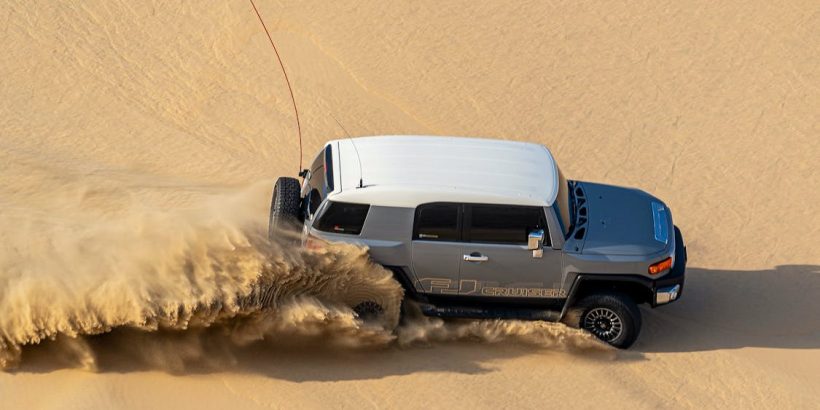When it comes to offroading, enthusiasts often seek ways to enhance their experience and safety. One quirky accessory that frequently comes up is the flag.
But not just any flag will do. Understanding the nuances surrounding the use of flags in offroad settings is critical. This article explores the reasons behind flag selection and its importance in offroad adventures.
The Purpose of Flags in Offroading
Flags serve multiple purposes during off-road excursions. Primarily, they are safety devices designed to increase visibility.
In environments where terrain can obscure vehicles, a brightly colored flag attached to a tall pole can help spot a vehicle from a distance.
This is particularly important in areas where larger vehicles may be navigating through rugged landscapes.
Moreover, flags help establish communication among offroaders. They can signal various conditions or intentions. For instance, a flag may indicate that a driver is stuck or requires assistance.
In group outings, these signals can be essential for maintaining cohesion and safety.
If you’re aiming to boost visibility and minimize trail hazards, consider investing in a reliable off road flag that meets the conditions of your terrain.
Flag Types and Their Significance
Not all flags are created equal. Different colors and designs convey different meanings. For example, a bright orange flag is commonly used as a standard in many offroading communities.
Its high visibility makes it easy to spot against various backdrops, whether it’s dirt, mud, or foliage. This flag signifies a vehicle in a potentially hazardous situation, warning others to proceed with caution.
In contrast, a flag that’s red may indicate danger, signaling that the vehicle is in a critical situation. Knowing the significance of these flags can enhance safety on the trails.
It’s not just a matter of flying a flag; it’s about understanding what that flag represents.
Legal Considerations in Flag Usage
The legality of using flags can also vary by region. Some offroad parks and trails have specific regulations regarding flag height, color, and placement.
Ignoring these regulations can lead to fines or even being asked to leave the area. Before hitting the trails, it’s wise to check local rules regarding flag usage.
When in doubt, adhering to the most common standards can help ensure compliance. This is especially true in areas where visibility is a concern; you wouldn’t want to risk an accident due to a simple oversight.
Height Matters: Why Size Counts
The height of the flagpole is another factor that should not be overlooked. Flags need to be tall enough to be seen over obstacles like hills or shrubbery.
A general guideline is to have the flagpole extend at least 10 feet above the vehicle. This height increases the chances of being spotted by other drivers, particularly in offroad settings where viewlines are often compromised.
Shorter flags can defeat the purpose entirely. If the flag isn’t elevated enough, it could become obscured by the very terrain offroaders are attempting to navigate.
So, when planning your offroad adventure, remember: taller is usually better.
Choosing the Right Materials
The flag’s material also plays a role in its effectiveness. Flags made from durable fabrics are preferable; they need to withstand wind, rain, and rough handling.
A flimsy flag may tear or become unreadable, negating its primary purpose. Many offroaders opt for flags made from nylon or polyester, as these materials offer a good balance of durability and visibility.
In addition to fabric, the pole itself should be sturdy. A flimsy pole may bend or break under pressure, leaving the flag useless. Investing in a quality flag and pole can be a small price to pay for enhanced safety on the trails.
Color Choices: What Works Best?

Color choice is paramount when selecting a flag for offroading. Bright colors like orange, yellow, and pink stand out well against natural backdrops.
On the flip side, darker colors can blend into the environment, making them less effective for visibility.
Think about the terrain you’ll be crossing. In sandy areas, a bright flag may work wonders, while in wooded regions, a different color might be preferable. The goal is to maximize visibility, so choose wisely.
Community Standards and Practices
Within different offroading communities, certain flags may have developed unique meanings or uses. Engaging with local offroad clubs or forums can provide insights into the best practices for your area.
You may find that certain trails have unspoken rules regarding flag use that, while not officially documented, are adhered to by the community.
Fostering relationships with fellow offroaders can also help you learn more about the tools and techniques they use. Sharing tips can be a great way to ensure everyone has a fun and safe experience.
Flags in Competitive Offroading
In competitive offroading settings, flags take on a new level of importance. Competitors must adhere to strict regulations regarding flag use, including colors, sizes, and placements.
Failure to comply can result in penalties. This competitive edge adds another layer to the importance of selecting the right flags.
In such events, flags also serve to inform officials and spectators about various aspects of the race. Knowing how to properly display a flag can mean the difference between winning and losing.
The Role of Technology in Flag Use
With the rise of technology, some offroaders have started using LED flags or other tech-enabled options. These modern alternatives can increase visibility, especially at night or in low-light conditions.
They can also be programmed to flash or change colors, providing various signals to fellow offroaders.
While traditional flags have their charm, it’s worth considering how technology can enhance safety and communication on the trails. However, technology should not replace the basics.
There’s still a need for a solid, traditional flag for visibility.
Maintenance and Care for Your Flags
Proper maintenance extends the life of your flag. Regularly inspect it for damage, especially after a rugged outing. A small tear can turn into a big issue if left unchecked.
Similarly, ensure that the pole is sturdy and free from rust or bends.
Cleaning your flag fabric occasionally can also help maintain its visibility. Dust and dirt can accumulate, dulling the brightness of colors. A quick wash can go a long way in ensuring your flag remains effective.
Understanding Your Environment
Before heading out, take some time to assess the environment you’ll be offroading in. Different terrains can affect how effective your flag is. In open, flat landscapes, a flag may be seen from a distance.
In contrast, in mountainous or heavily wooded areas, visibility may be limited.
Adapting your flag strategy to match your environment can improve safety and communication. Regardless of your chosen offroad destination, being aware of these conditions is key.
The Bigger Picture: Safety First
Using flags in offroading isn’t merely about the flags themselves; it’s about creating a culture of safety. Each flag serves as a reminder to prioritize visibility and communication.
Offroading can be exhilarating, but it also comes with its own set of risks. By using flags correctly, drivers can help mitigate those risks.
Establishing good practices around flag use fosters a safer environment for everyone involved. Engaging with fellow enthusiasts to share tips and experiences can lead to a safer and more enjoyable offroading experience overall.
In the grand scheme of offroading, flags may seem like a minor detail, but they play a significant role. The right flag can keep you and your fellow adventurers safe while enhancing the fun of your offroad excursions.

